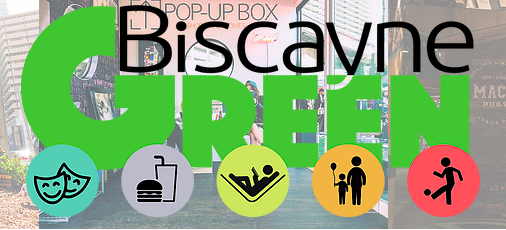Just for three weeks, cars will make way for people on Biscayne Boulevard downtown || via Miami Herald
BY ANDRES VIGLUCCI
via || MIAMI DDA
Biscayne Boulevard in downtown Miami, the city’s foyer, functions today as little more than a funnel for cars and trucks: eight or nine lanes of careening traffic and six blocks of median parking leave scant room for people, at a time when thousands of new residents are moving into the neighborhood’s growing concrete jungle.
What if the proportions were reversed? Would it be better instead to turn over much of that valuable public space to people, to pedestrians and cyclists and basketball players, to diners and playing children and music-lovers?
That’s just what the Downtown Development Authority has proposed, and Miamians will get a taste of how it all might work starting Friday. For three weeks, three blocks of parking under the Metromover guideway straddling Flagler Street will be temporarily occupied by pop-up public plazas enlivened by a program of concerts, movie screenings, dance and yoga lessons, and food and beer tastings.
Since Tuesday, crews have been out depositing mulch, painting over asphalt and installing a turf rug to get the pop-up ready for its debut Friday evening during a free event with musical headliners Locos por Juana. Two lanes of southbound traffic on the boulevard, meanwhile, will be re-dedicated for on-street parking and Metrobuses only.
The $250,000 Biscayne Green demonstration project, funded by private grants and the DDA, aims to drum up public enthusiasm for performing radical surgery on the six-block stretch from the Intercontinental Hotel to AmericanAirlines Arena. The long-term DDA plan on which it’s based, issued last year, would turn what’s now a highway that divides the downtown core from Bayfront Park and Biscayne Bay into an inviting, pedestrian- and bike-friendly urban promenade akin to Barcelona’s famed Las Ramblas or Madrid’s Paseo del Prado.
“The temporary installation is to get people to imagine what could be,” DDA director Alyce Robertson said. “We’ve got all these new residents downtown. One of the main goals for our master plan is to make downtown Miami more walkable, more livable. Biscayne Boulevard is our front door, so let’s take back some of the real estate from cars and make it a grand promenade that belongs to the people.”
Robertson and the DDA’s planners acknowledge that the long-term undertaking would require a change in some ingrained habits and a different way of looking at that piece of Biscayne Boulevard — as more of a public space that prioritizes pedestrians and their safety and ease instead of moving cars through quickly. The Biscayne Green concept has its origins in efforts by the DDA to improve safety for people trying to cross the boulevard on foot, an arduous and at times intimidating endeavor, Robertson said.
via || Biscaynegreenmiami.com
In the long run, pending approvals by the state, city and county, the plan would take out most of the median parking for a series of public spaces. It would also turn two lanes of motorized traffic in each direction into bike lanes and transit-only lanes, while restoring on-street automobile parking along the boulevard, all of which helps slow down traffic and buffers pedestrians on sidewalks from moving cars. Narrowing the roadway would also make the crossing shorter, safer and more convenient for pedestrians, the DDA says.
The DDA just won a $422,000 grant from the Florida Department of Transportation for a study of the impact of eliminating lanes. Other cities that have slimmed down streets in congested areas, like Manhattan’s Times Square, to create more room for pedestrians and loungers have found that traffic actually flows better and that, as expected, safety for people on foot and on bikes improves markedly.
Because the boulevard already narrows north of the AAA and as it curves at the Miami River, DDA planners don’t believe that taking lanes out between the two spots would significantly affect car-traffic flow, or that those extra lanes offer any real benefit at all. They say the Biscayne Green plan reflects a better balance between the needs of motorists and demand for more pedestrian- and bike-friendly spaces from downtown residents and workers, and is patterned on best practices followed in other major cities.
“We need to start reallocating street space for pedestrians,” said Tony Garcia, principal at Street Plans Collaborative, a planning consultant that’s helping the DDA set up the temporary Biscayne Green, while stressing the project for now “is just a test.”
“It’s a way of getting people comfortable with these things that are done in other places,” Garcia said.
Visitors to the temporary Biscayne Green are encouraged to take Metromover, bike or, of course, walk there. CitiBikes is installing temporary docking stations. Crews are also repainting street crossings in new, eye-catching patterns to lure pedestrians and reinforce their temporary primacy to motorists.
The first block, under the Bayfront Park Metromover station, will have food trucks and seating and tables for public presentations and planning meetings, Garcia said. The second, to its north, will be a mini-park, with exercise stations, a kids’ playground, dog park, fire pit and small-scale reproduction of the Chinese Bridge by the Deering Estate. The northernmost block will be a plaza for hanging out, with seating and tables for eating, as well as a small performance stage.
“There’s been a lot of people walking around and asking what we’re doing,” Garcia said Thursday as he worked on the set-up with city, Miami-Dade County and DDA crews as well as volunteers from Wynwood maker space Moonlighter, who made furniture for the project. “The response has been overwhelmingly positive. Especially from doggy people.”

